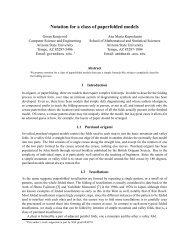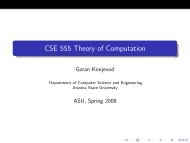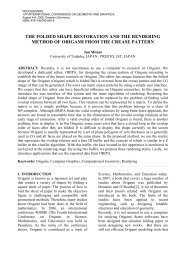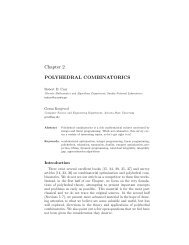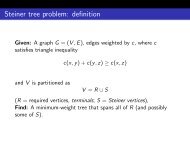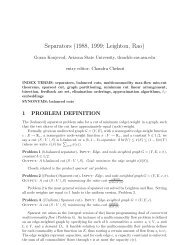Set cover problem: definition - Organic Origami
Set cover problem: definition - Organic Origami
Set cover problem: definition - Organic Origami
You also want an ePaper? Increase the reach of your titles
YUMPU automatically turns print PDFs into web optimized ePapers that Google loves.
<strong>Set</strong> <strong>cover</strong> <strong>problem</strong>: <strong>definition</strong><br />
Given: A finite set (universe) U of n elements, a collection of its<br />
subsets S 1 , . . . , S k . Each set S i has a nonnegative cost cost(S).<br />
Find: A minimum-cost collection of these subsets whose union is<br />
U.
Greedy algorithm<br />
Idea: <strong>cover</strong> most elements per unit cost in each step.<br />
1 C ← ∅<br />
2 While C ≠ U:<br />
3 Let S be the most cost-effective set in the current<br />
iteration<br />
4 Let α = cost(S) , the cost-effectiveness of S.<br />
|S∩C|<br />
5 Pick S.<br />
6 For each e ∈ S \ C, set price(e) = α.<br />
7 Output the picked sets.
<strong>Set</strong> <strong>cover</strong> greedy: analysis<br />
Suppose the elements are picked in order e 1 , e 2 , . . . , e n .<br />
Lemma<br />
For every k = 1, . . . , n, price(e i ) ≤<br />
OPT<br />
n−k+1 .<br />
Proof.<br />
At any time during greedy, compare what is left to be <strong>cover</strong>ed and<br />
the sets of the optimal solution that have not been used. These<br />
sets together cost at most OPT and <strong>cover</strong> at least |C|. Therefore,<br />
the most cost-effective set has α ≤ OPT /|C|.<br />
In iteration that <strong>cover</strong>ed e k , |C| ≥ n − k + 1. Thus<br />
price(e k ) ≤ OPT<br />
|C|<br />
≤<br />
OPT<br />
n − k + 1
Greedy set <strong>cover</strong> analysis (2)<br />
Theorem<br />
Greedy is an H n approximation algorithm for set <strong>cover</strong><br />
(H n = 1 + 1/2 + · · · + 1/n).<br />
Proof.<br />
The cost of each chosen set is the sum of its elements’ prices. The<br />
total cost of the set <strong>cover</strong> is<br />
n∑<br />
price(e k ) ≤ OPT (1 + 1 2 + 1 3 + · · · + 1 n ).<br />
k=1
Is the analysis tight?<br />
There’s an example in the book....
Can we do better?<br />
Actually, NO!<br />
It has been shown that for any c > 0, if there is an approximation<br />
algorithm for set <strong>cover</strong> with guarantee at most (1 − c) ln n, then<br />
(well, not actually P=NP, but something just as unlikely: every<br />
<strong>problem</strong> in NP could then be solved in time O(n polylog(n) ), which is<br />
not thought to be possible. . . )
A completely different approach: linear programming<br />
How to formulate set <strong>cover</strong> as an ILP?<br />
Solution: some sets.<br />
So, variables: tell us which sets have been selected.<br />
x S = 1 iff S is part of the solution, x S = 0 otherwise.<br />
Cost: ∑ S∈S c(S)x S.<br />
Constraints say we have to <strong>cover</strong> every element e: ∑ S: e∈S x S ≥ 1.
<strong>Set</strong> <strong>cover</strong> (I)LP<br />
min ∑ s∈S<br />
c(S)x S<br />
s.t.<br />
∑<br />
x S ≥ 1, ∀e ∈ U<br />
S: e∈S<br />
x S ∈ {0, 1} ∀S ∈ S<br />
To get a polynomially solvable relaxation, replace the 0-1<br />
constraints by 0 ≤ x S ≤ 1 for all S.
<strong>Set</strong> <strong>cover</strong> rounding<br />
How to round? Deterministically, it’s not easy to get a good<br />
bound. However, randomized rounding here is very simple.<br />
<strong>Set</strong> <strong>cover</strong> randomized rounding procedure:<br />
Suppose xS ∗ for every S are the values of x S in the optimal LP<br />
solution.<br />
For each S independently, flip a coin biased by xS ∗ , so that<br />
S is included in the <strong>cover</strong> with probability exactly xS ∗.<br />
Write x S for the rounded value of x S .<br />
Easy: the expected cost of this rounding procedure is<br />
∑<br />
c(S) P[x S = 1] = ∑ c(S)xS ∗ = OPT LP ≤ OPT .<br />
S<br />
S<br />
How about the success probability?
<strong>Set</strong> <strong>cover</strong> rounding: success probability<br />
For any e ∈ U, let k e be the number of sets containing e. Then,<br />
P[e is <strong>cover</strong>ed] = 1 − ∏<br />
(1 − xS ∗ )<br />
S: e∈S<br />
≥ 1 − ( k e − ( ∑ S: e∈S x S ∗)<br />
) 1/ke<br />
k e<br />
≥ 1 − (1 − 1 k e<br />
) 1/ke ≥ 1 − 1 e .<br />
(First line to second line: geometric-arithmetic inequality)<br />
(Second line to third: ∑ S: e∈S x S ≥ 1.)
<strong>Set</strong> <strong>cover</strong> rounding: success probability (2)<br />
From previous slide: For every e, the probability e is <strong>cover</strong>ed is at<br />
least 1/2.<br />
Repeat the rounding (independently) 2 lg n times, take the union of<br />
all (partial) <strong>cover</strong>s found. Then<br />
1 The expected total cost is at most 2 lg nOPT<br />
2 The probability e is not <strong>cover</strong>ed is at most<br />
(1/2) 2 lg n < 1/(2n). The probability there is an un<strong>cover</strong>ed<br />
element is (by union bound) at most 1/2.<br />
Is this tight?



